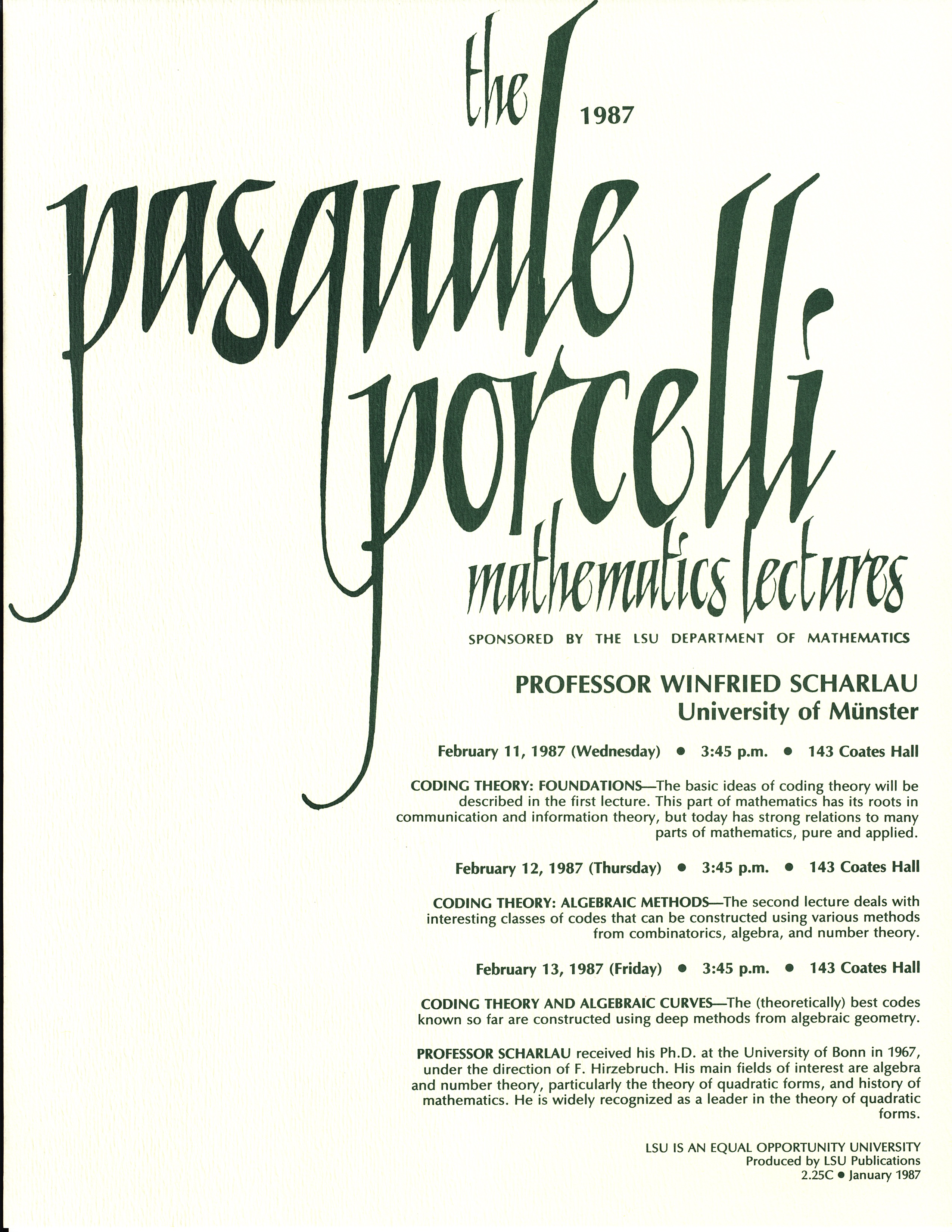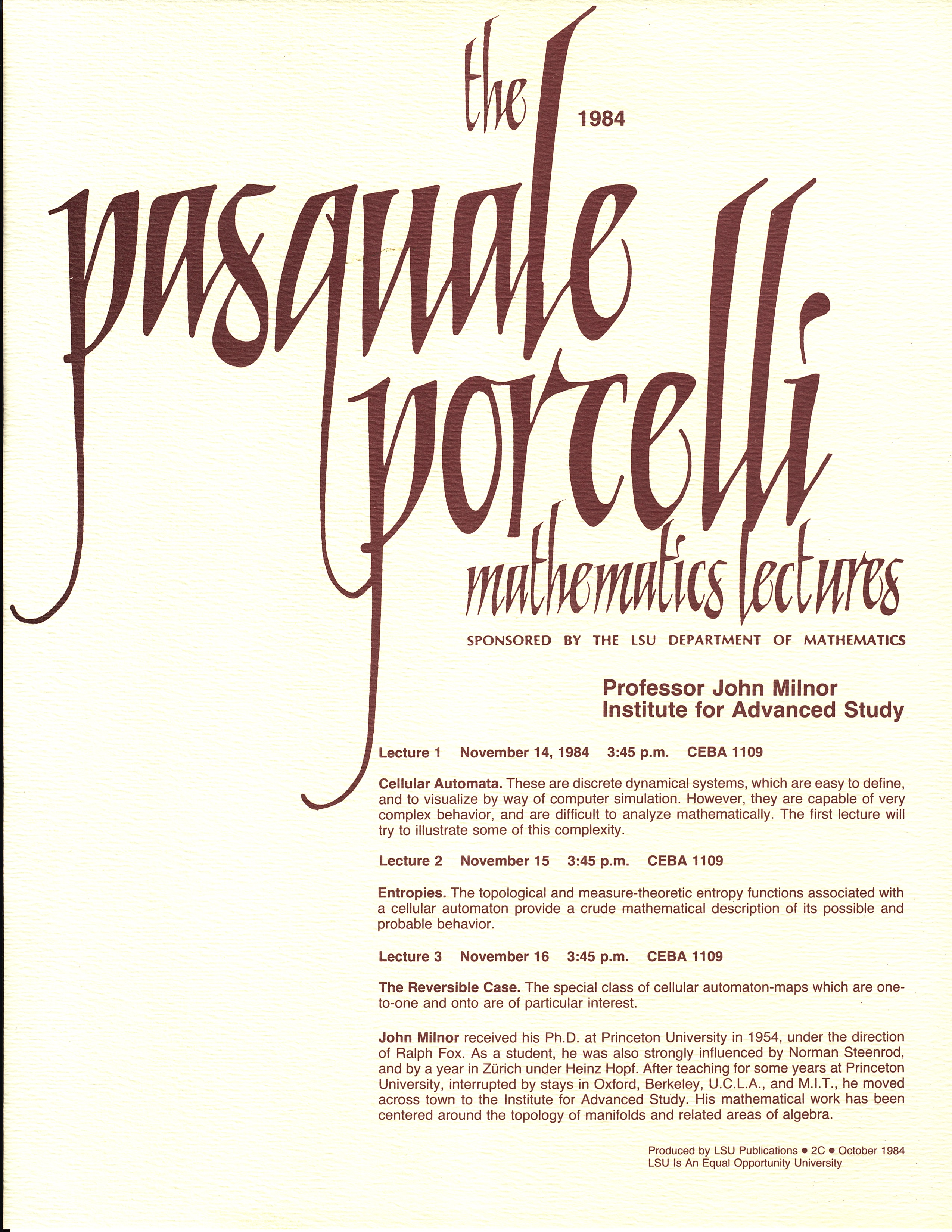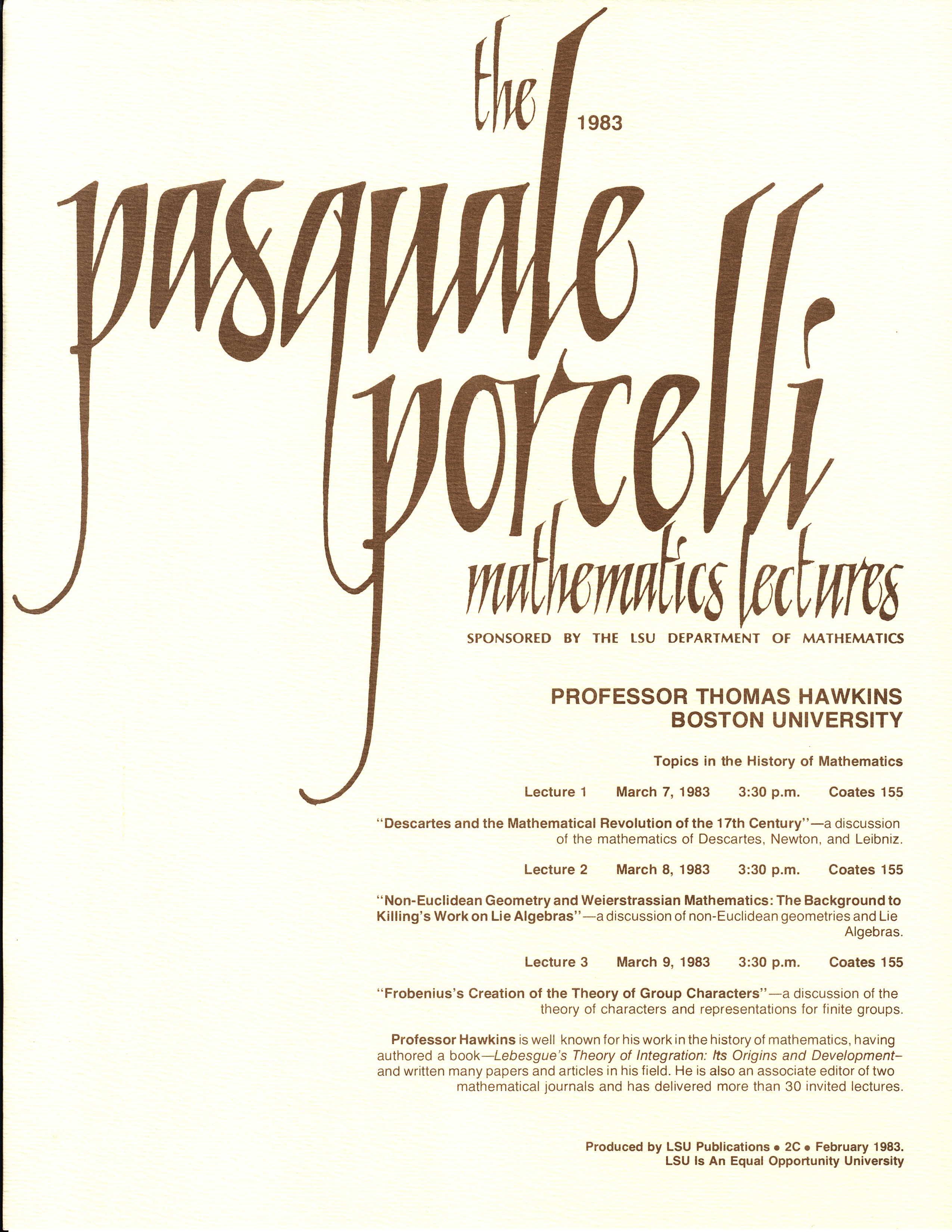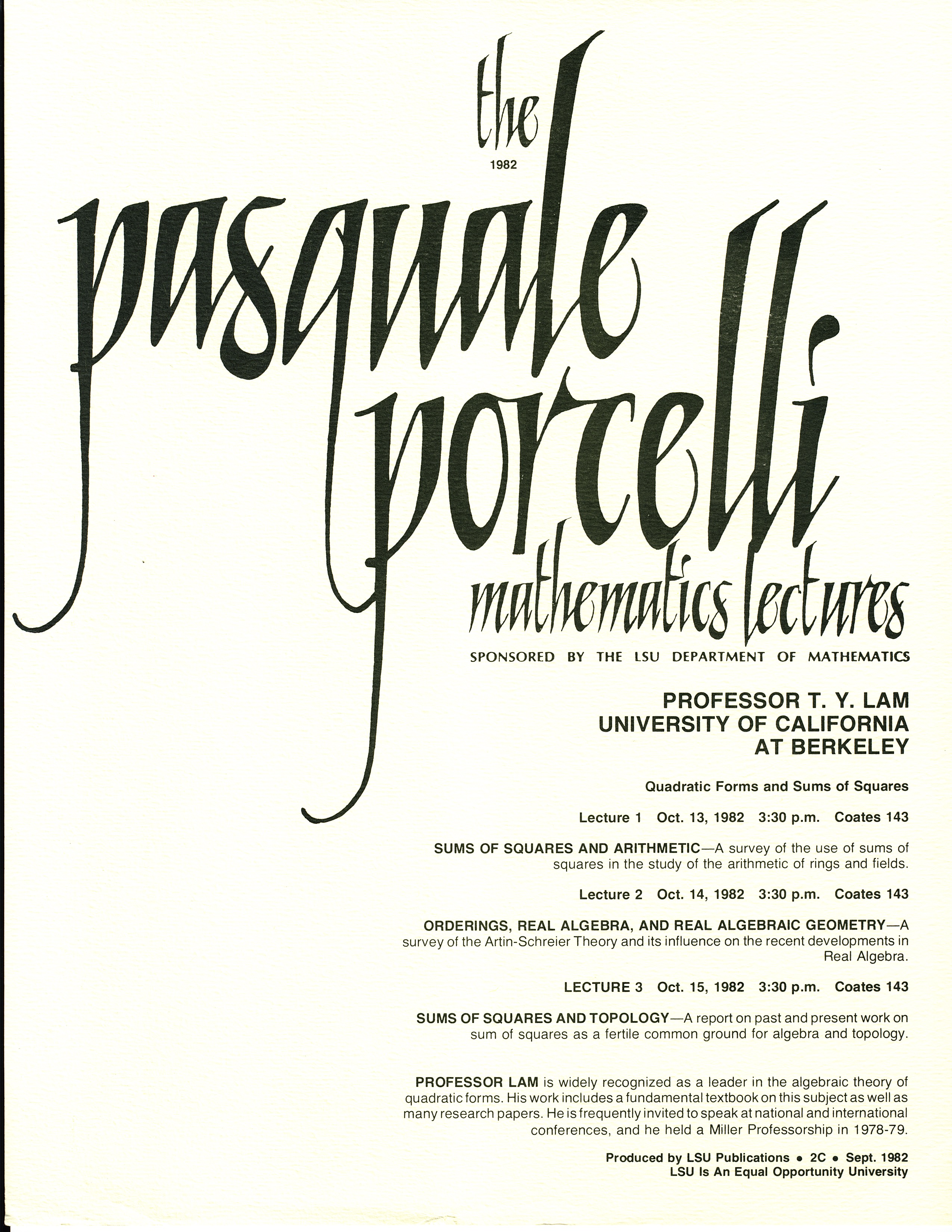Porcelli Lecture Series
 The Pasquale Porcelli Lecture Series in mathematics is an annual event in which a prominent mathematician is invited to deliver a series of lectures on recent advances in an area of mathematical research. The topics and the level of the lectures are carefully chosen to appeal to a broad audience from various academic disciplines. Everyone is invited to attend!
The Pasquale Porcelli Lecture Series in mathematics is an annual event in which a prominent mathematician is invited to deliver a series of lectures on recent advances in an area of mathematical research. The topics and the level of the lectures are carefully chosen to appeal to a broad audience from various academic disciplines. Everyone is invited to attend!
The Lecture Series is funded by the family of Pasquale Porcelli, who was a mathematics professor at LSU from 1959 until his death in 1972. Porcelli was made Boyd Professor—the highest LSU rank—in 1965. Two of Porcelli's LSU doctoral students became Sloan Fellows after graduating from LSU.
(2024) R. Tyrrell Rockafellar, University of Washington
Lecture 1: Monday, March 4, 2024, 3:30 p.m., Atchafalaya Room, LSU Student Union
Risk and Uncertainty in Optimization
New mathematics is on the forefront in many emerging areas of technology, and its methods for sorting out ideas and testing for truth and shortcomings are as vital as ever. This talk aims to explain how that has worked in confronting “risk”. Problems of optimization are concerned with deciding things “optimally”. In many situations in management, finance, and engineering design, however, plans have to be fixed in the present without knowing fully how they will play out in the future. A future cost or hazard may depend on random variables with probability distributions that a present decision can only influence in a limited way. Should optimization then rely on average outcomes? Worst-case outcomes? High-probability avoidance of dangerous outcomes? Or what? This is a subject with a history of competing approaches that reached a turning point with the axiomatic development of a powerful theory of risk. The mathematical concepts and results from that have been overturning tradition in one important area of application after another.
Lecture 2: Tuesday, March 5, 2024, 2:30 p.m., Hill Memorial Library
Variational Analysis and Geometry
The theory needed for problems of optimization has required vast developments of a kind of alternative calculus in which, for instance, discontinuous functions that might take on infinite values nonetheless have “subgradients” which are highly useful. In maximizing and minimizing, variables are often required to be nonnegative, or to have values not too high or too low. This leads to a fascinatingly different nonclassical kind of geometry.
Lecture 3: Wednesday, March 6, 2024, 2:30 p.m., Hill Memorial Library
Variational Convexity and Local Optimality
For necessary and sufficient conditions for local optimality, the inherited ideal has been for them to be as close to each other as possible. In optimization, however, what’s more important is sufficient conditions that identify key common features in a problem which support algorithmic developments. Variational convexity, although only recently identified as such a condition, appears to be fundamentally important.
Learn more about R. Tyrrell Rockafellar [Wikipedia].
(2019) Robert Bryant, Duke University
Lecture 1: Thursday, March 28, 2019, 4:00 p.m., 130 Nicholson Hall
Mathematical Mysteries of the Ellipse
After lines and circles, the simplest curves are the so-called conic sections, hyperbolas, parabolas, and ellipses. Not only are they the next simplest curves, but they have many applications in the physical world and have been studied for more than two thousand years.
However, these curves have many surprising properties that were not discovered until fairly recently.
For example, it has been known for a long time that light emitted from one focus of an ellipse collects at the other focus, and a similar property for the parabola is used in designing headlights. However, this turns out to be a special case of a much more interesting and surprising special property discovered in the 19th century and that has given rise to problems that we still don't know how to solve today.
In this talk, which will use nothing beyond high school algebra (and lots of pictures), I'll explain some of these mysteries and why we study them.
Lecture 2: Friday, March 29, 2019, 2:30 p.m., 130 Howe-Russell
Geometry Old and New: From Euclid to String Theory
Classical geometry is based on notions of symmetry and congruence, and these ideas, while very old, have deeply influenced our understanding of the physical world. The idea of modeling the world through principles of least action or least energy are tied to symmetry in deep ways. In this talk, I will survey the history of how this relationship was uncovered by mathematicians such as Euler, Gauss, Lie, and Noether and is still developing in our modern understanding of the world, from Einstein's theory of relativity even to contemporary versions of string theory.
Lecture 3: Friday, March 29, 2019, 4:10 p.m., 130 Howe-Russell
The Best Possible Shapes of Surfaces
Much of classical mathematics involves finding a configuration or shape that provides an optimum solution of a problem. For example, it has long been known (though a rigorous proof took quite a while to find) that the surface of least area enclosing a given volume is a round sphere. There are many other ways to measure surfaces, though, and finding 'the' surface that optimizes a given 'measurement' (subject to some given constraints) remains a challenging problem that has motivated some of the deepest recent work in the mathematics of geometric shapes.
In this talk, I will explain some of the classic ways to measure shapes of surfaces and relate this to classical problems involving surface area (soap films and bubbles) and total curvature as well to as recent progress by myself and others on these important optimization problems.
- Robert Bryant [math.duke.edu] (Fellow, American Academy of Arts and Sciences (2002), Member, National Academy of Sciences (2007), AMS Fellow (2013), AMS President (2015-2017) )
- Poster 1
- Poster 2
(2018) Irene Fonseca, Carnegie Mellon
Lecture 1: Wednesday, April 4, 2018, 2:30 p.m., Dodson Auditorium
Mathematics and Imaging Science
(The talk is intended to be accessible to High School Students.) In this talk, we will address the mathematical treatment of image processing, including inpainting, recolorization, denoising, and machine learning schemes.
Lecture 2: Wednesday, April 4, 2018, 4:10 p.m., Dodson Auditorium
Mathematics and Materials Science
(Intended to be accessible to Undergraduate Students.) Quantum dots are man-made nanocrystals of semiconducting materials. Their formation and assembly patterns play a central role in nanotechnology, and in particular in the optoelectronic properties of semiconductors. Changing the dots' size and shape gives rise to many applications that permeate our daily lives, such as the new Samsung QLED TV monitor that uses quantum dots to turn “light into perfect color”! Quantum dots are obtained via the deposition of a crystalline overlayer (epitaxial film) on a crystalline substrate. When the thickness of the film reaches a critical value, the profile of the film becomes corrugated and islands (quantum dots) form. As the creation of quantum dots evolves with time, materials defects appear. Their modeling is of great interest in materials science since material properties, including rigidity and conductivity, can be strongly influenced by the presence of defects such as dislocations. In this talk, we will use methods from the calculus of variations and partial differential equations to model and mathematically analyze the onset of quantum dots, the regularity and evolution of their shapes, and the nucleation and motion of dislocations.
Lecture 3: Thursday, April 5, 2018, 10:30 a.m., Digital Media Center Theater
Homogenization of Integral Energies Under Periodically Oscillating Differential Constraints
(The talk is intended to be accessible to Graduate Students.) A homogenization result for a family of integral energies is presented, where the fields are subjected to periodic first order oscillating differential constraints in divergence form. We will give an example that illustrates that, in general, when the operators differential operators have non constant coefficients then the homogenized functional maybe be nonlocal, even when the energy density is convex. This work is based on the theory of A-quasiconvexity with variable coefficients and on two-scale convergence techniques.
(2017) Ken Ono, Emory University
Lecture 1: Wednesday, April 19, 2017, 3:30 p.m., 130 Howe-Russell Hall
Gems of Ramanujan and Their Lasting Impact on Mathematics
Ramanujan's work has has a truly transformative effect on modern mathematics, and continues to do so as we understand further lines from his letters and notebooks. In this lecture, some of the studies of Ramanujan that are most accessible to the general public will be presented and how Ramanujan's findings fundamentally changed modern mathematics, and also influenced the lecturer's work, will be discussed. The speaker is an Associate Producer of the film The Man Who Knew Infinity (starring Dev Patel and Jeremy Irons) about Ramanujan. He will share several clips from the film in the lecture.
Lecture 2: Thursday, April 20, 2017, 3:30 p.m., Dodson Auditorium
Cool Theorems Proved by Undergraduates
The speaker has been organizing summer research programs for undergraduate students for many years. This lecture will give a sample of their accomplishments. The speaker will talk about partitioning integers, prime numbers, number fields, and generalizations of classical theorems of Euler, Gauss, and Jacobi.
Lecture 3: Friday, April 21, 2017, 3:30 p.m., Dodson Auditorium
Can't You Just Feel the Moonshine?
Borcherds won the Fields medal in 1998 for his proof of the Monstrous Moonshine Conjecture. Loosely speaking, the conjecture asserts that the representation theory of the Monster, the largest sporadic finite simple group, is dictated by the Fourier expansions of a distinguished set of modular functions. This conjecture arose from astonishing coincidences noticed by finite group theorists and arithmetic geometers in the 1970s. Recently, mathematical physicists have revisited moonshine, and they discovered evidence of undiscovered moonshine which some believe will have applications to string theory and 3d quantum gravity. The speaker and his collaborators have been developing the mathematical facets of this theory, and have proved the conjectures which have been formulated. These results include a proof of the Umbral Moonshine Conjecture, and Moonshine for the first sporadic finite simple group which does not occur as a subgroup or subquotient of the Monster. The most recent Moonshine (announced here) yields unexpected applications to the arithmetic elliptic curves thanks to theorems related to the Birch and Swinnerton-Dyer Conjecture and the Main Conjectures of Iwasawa theory for modular forms. This is joint work with John Duncan, Michael Griffin and Michael Mertens.
(2016) Maria Chudnovsky, Princeton University
Lecture 1: Wednesday, May 4, 2016, 3:30 p.m., DMC Theatre
Perfection and Beyond
About 10 years ago one of the central open problems in graph theory at the time, the Strong Perfect Graph Conjecture, was solved. The proof used structural graph theory methods, and spanned 155 journal pages. The speaker was part of the team of authors of this mathematical beast. In this talk we will explain the problem, describe some of the ideas of the proof (that has since been shortened somewhat), and discuss related problems that have been a subject of more recent research.
Lecture 2: Thursday, May 5, 2016, 10:30 a.m., DMC Theatre
Coloring some perfect graphs
Perfect graphs are a class of graphs that behave particularly
well with respect to coloring. In the 1960s, Claude Berge made two
conjectures about this class of graphs, that motivated a great deal of
research, and by now they have both been solved.
The following remained open however: design a combinatorial algorithm that
produces an optimal coloring of a perfect graph. Recently, we were able to
make progress on this question, and we will discuss it in this talk. Last
year, in joint work with Lo, Maffray, Trotignon and Vuskovic we were able
to construct such an algorithm under the additional assumption that the
input graph is square-free (contains no induced four-cycle). More
recently, together with Lagoutte, Seymour and Spirkl, we solved another
case of the problem, when the clique number of the input graph is fixed
(and not part of the input).
Lecture 3: Thursday, May 5, 2016, 3:30 p.m., DMC Theatre
Induced cycles and coloring
The Strong Perfect Graph Theorem states that graphs with no no induced odd cycle of length at least five, and no complements of one behave very well with respect to coloring. But what happens if only some induced cycles (and no complements) are excluded? Gyarfas made a number of conjectures on this topic, asserting that in many cases the chromatic number is bounded by a function of the clique number. In this talk we discuss recent progress on some of these conjectures. This is joint work with Alex Scott and Paul Seymour.
- Learn more about Maria Chudnovsky [Wikipedia]
- YouTube
(2014) Susan A. Murphy, University of Michigan
Lecture 1: Monday, April 28, 2014, 3:30 p.m., Digital Media Center Theater
Getting SMART about Adapting Interventions
Imagine you are a child with ADHD. Wouldn't you like your doctors to periodically adapt your treatment to your unique—and ever-changing—condition? And wouldn't you be excited to learn that an algorithm used to analyze your medical data was originally developed for applications in robotics and artificial intelligence? This lecture will explain how a randomized clinical trial design (Sequential Multiple Assignment Randomized Trial or SMART) is being used to develop adaptive interventions—protocols that systematize sequential decision-making that is key to effective treatment of health problems. Examples include a study of children with ADHD and an ongoing study to improve care at mental health clinics.
Lecture 2: Monday, April 28, 2014, 4:30 p.m., Digital Media Center Theater
Adaptive Confidence Intervals for Non-Smooth Parameters
Non-regular, aka “non-smooth” parameters are of scientific interest occur frequently in modern day inference. In particular when scientific interest centers on a non-smooth function of regular parameters such as in the assessment of a machine learning classifier's performance, in the estimation of multistage decision making policies and in the use of methods that use assumptions of sparsity to threshold estimators. If confidence intervals are considered at all, most research assumes potentially implausible “margin-like” conditions in order to justify the proposed confidence interval method. We describe a different approach based on constructing smooth upper and lower bounds on the parameter and then basing the confidence interval on the smooth upper and lower bounds. In particular two settings will be discussed and contrasted, that of a confidence interval for the misclassification rate and a confidence interval for a parameter in multistage decision making policies.
Learn more about Susan A. Murphy [Wikipedia].
(2013) S. R. Srinivasa Varadhan, Courant Institute, New York
Lecture 1: Wednesday, April 17, 2013, 4:30 pm, 103 Design Building What is large deviations?
Lecture 2: Thursday, April 18, 2013, 4:30 pm, 103 Design Building
Scaling limits of large systems
Lecture 3: Friday, April 19, 2013, 4:30 pm, 103 Design Building
Counting Graphs
(2011) Lawrence C. Evans, University of California, Berkeley
Lecture 1: Tuesday, March 22, 2011, 3:40 p.m., 103 Design Auditorium
Linearity and linearization
In this expository lecture aimed at a general audience, I will first discuss the profound advantages of linear structure in mathematical problems and then survey several interesting ways to “linearize” nonlinear problems, primarily differential equations. Examples and applications will include perturbation and implicit function procedures, blow-up techniques, kinetic formulations, and adjoint methods based upon formal linearization.
Lecture 2: Wednesday, March 23, 2011, 3:40 p.m., 103 Design Auditorium
Convexity as one-sided linearity
I will continue the themes of the previous talk, surveying for differential equations various convexity methods that can be interpreted as “one-sided linearity” tricks. These are especially useful since, as I will show, several important and highly nonlinear problems possess "hidden" convex structures of various sorts.
Lecture 3: Thursday, March 24, 2011, 3:40 p.m., 103 Design Auditorium
Linear adjoint methods for sup-norm variational problems
This final lecture will present some technical details about a recent application of linearization and adjoint methods for proving differentiability for weak solutions of the so-called “infinity Laplacian” PDE. This highly degenerate and nonlinear equation is fundamental in the emerging field of sup-norm variational problems and their applications.
(2008) Don Zagier, Max Planck Institute for Mathematics, Bonn, Germany
Lecture 1: Wednesday, April 23, 2008, 3:40 p.m., 130 Howe-Russell
The “q” in “q-series”
Lecture 2: Thursday, April 24, 2008, 3:40 p.m., 130 Howe-Russell
The “q” in “quadratic”
Lecture 3: Friday, April 25, 2008, 3:40 p.m., 130 Howe-Russell
The “q” in “quantum”
(2007) Richard V. Kadison, University of Pennsylvania
The Pythagorean Theorem from another, slightly sophisticated, point of view
Lecture 1: Tuesday, April 10, 2007, 3:40 p.m., 130 Howe-Russell Geoscience Complex
The Pythagorean Theorem: A Closer Look
Extensions and variants of the Pythagorean theorem are presented, first from the point of view of finite-dimensional, linear algebra and, later, in the framework of infinite-dimensional Hilbert space. The results discussed make contact with the work of Kostant, Atiyah, and Guillemin-Sternberg in the convex geometry of symmetric spaces, the work of Horn and Schur on spectral theory, matrix inequalities, majorization, and convex polytopes, and semi-commutative, metric geometry from the point of view of conditional expectations. The first of the two Pythagoras lectures will be relatively elementary, the second will be slightly more advanced, relying somewhat on the operator-algebra survey lecture that follows the first lecture.
Lecture 2: Wednesday, April 11, 2007, 3:40 p.m., 130 Howe-Russell Geoscience Complex
Operator Algebras: A Sampler
Lecture 3: Thursday, April 12, 2007, 3:40 p.m., 130 Howe-Russell Geoscience Complex
The Pythagorean Theorem: An Advanced View
Dr. Richard V. Kadison is a world leader in the field of operator algebras, the theory that provides the mathematical basics for quantum mechanics. He has written and coauthored several books on the subject and around 100 articles. He is a member of the National Academy of Sciences since 1996, a foreign member of the Danish Royal and the Norwegian Academies of Science and Letters, and the recipient of numerous awards including Guggenheim and Sloan Fellowships and a Fulbright research Fellowship. In 1999 he received the Steele Prize for Lifetime Achievement from the American Mathematical Society.
(2003) Vaughan Jones, University of California at Berkeley
Vaughan Jones
(2001) Martin Golubitsky, University of Houston
Martin Golubitsky
(2000) Dominic Welsh, Oxford University, England
Dominic Welsh
(1997) Avner Friedman, University of Minnesota
Learn more about Avner Friedman [Wikipedia].
(YouTube)
(1995) Louis H. Kauffman, University of Illinois at Chicago
Learn more about Louis H. Kauffman [Wikipedia].
(YouTube)
(1989) Heinz-Otto Peitgen, University of California at Santa Cruz
Learn more about Heinz-Otto Peitgen [Wikipedia].
(Poster)
(1987) Winfried Scharlau, University of Münster, Germany
Lectures
Lecture 1, February 11, 1987 (Wednesday), 3:45 p.m., 143 Coates Hall
Coding Theory: Foundations
The basic ideas of coding theory will be described in the first lecture. This part of mathematics has its roots in communication and information theory, but today has strong relations to many parts of mathematics, pure and applied.
Lecture 2, February 12, 1987 (Thursday), 3:45 p.m., 143 Coates Hall
Coding Theory: Algebraic Methods
The second lecture deals with interesting classes of codes that can be constructed using various methods
from combinatorics, algebra, and number theory.
Lecture 3, February 13, 1987 (Friday), 3:45 p.m., 143 Coates Hall
Coding Theory and Algebraic Curves
The (theoretically) best codes known so far are constructed using deep methods from algebraic geometry.
Professor Scharlau received his Ph.D. at the University of Bonn in 1967, under the direction of F. Hirzebruch. His main fields of interest are algebra and number theory, particularly the theory of quadratic forms, and history of mathematics. He is widely recognized as a leader in the theory of quadratic forms.
Learn more about Winfried Scharlau [Wikipedia].
(1986) Kiyosi Itô, Kyoto University, Japan
Learn more about Kiyosi Itô [Wikipedia].
(1985) H.W. Lenstra Jr., University of Amsterdam, Netherlands
Learn more about H.W. Lenstra Jr. [Wikipedia].
(1984) John Milnor, Institute for Advanced Study
Lectures
Lecture 1, November 14, 1984, 3:45 p.m., CEBA 1109
Cellular Automata
These are discrete dynamical systems, which are easy to define, and to visualize by way of computer simulation. However, they are capable of very complex behavior, and are difficult to analyze mathematically. The first lecture will try to illustrate some of this complexity.
Lecture 2, November 15, 1984, 3:45 p.m., CEBA 1109
Entropies
The topological and measure-theoretic entropy functions associated with a cellular automaton provide a crude mathematical description of its possible and probable behavior.
Lecture 3, November 16, 1984, 3:45 p.m., CEBA 1109
The Reversible Case
The special class of cellular automaton-maps which are one-to-one and onto are of particular interest.
John Milnor received his Ph.D. at Princeton University in 1954, under the direction of Ralph Fox. As a student, he was also strongly influenced by Norman Steenrod, and by a year in Zürich under Heinz Hopf. After teaching for some years at Princeton University, interrupted by stays in Oxford, Berkeley, U.C.L.A., and M.I.T., he moved across town to the Institute for Advanced Study. His mathematical work has been centered around the topology of manifolds and related areas of algebra.
Learn more about John Milnor [Wikipedia].
(1983) Thomas Hawkins, Boston University
Topics in the History of Mathematics
Lecture 1, March 7, 1983, 3:30 p.m., Coates 155
Descartes and the Mathematical Revolution of the 17th Century
A discussion of the mathematics of Descartes, Newton, and Leibniz.
Lecture 2, March 8, 1983, 3:30 p.m., Coates 155
Non-Euclidean Geometry and Weierstrassian Mathematics: The Background to Killing's Work on Lie Algebras
A discussion of non-Euclidean geometries and Lie Algebras.
Lecture 3, March 9, 1983, 3:30 p.m., Coates 155
Frobenius's Creation of the Theory of Group Characters
A discussion of the theory of characters and representations of finite groups.
Professor Hawkins is well known for his work in the history of mathematics, having authored a book—Lebesgue's Theory of Integration: Its Origins and Development—and written many papers and articles in his field. He is also an associate editor of two mathematical journals and has delivered more than 30 invited lectures.
Learn more about Thomas Hawkins [Wikipedia].
(1982) T.Y. Lam, University of California at Berkeley
Quadratic Forms and Sums of Squares
Lecture 1: Oct. 13, 1982, 3:30 p.m., Coates 143
Sums of Squares and Arithmetic
A survey of the use of sums of squares in the study of the arithmetic of rings and fields.
Lecture 2: Oct. 14, 1982, 3:30 p.m., Coates 143
Orderings, Real Algebra, and Real Algebraic Geometry
A survey of the Artin-Schreier Theory and its influence on the recent developments in Real Algebra.
Lecture 3: Oct. 15, 1982, 3:30 p.m., Coates 143
Sums of Squares and Topology
A report on past and present work on sums of squares as a fertile common ground for algebra and topology.
Professor Lam is widely recognized as a leader in the algebraic theory of quadratic forms. His work includes a fundamental textbook on this subject as well as many research papers. He is frequently invited to speak at national and international conferences, and he held a Miller Professorship in 1978-79.
Learn more about T.Y. Lam [Wikipedia].
(1981) Paul H. Rabinowitz, University of Wisconsin
Learn more about Paul H. Rabinowitz [Wikipedia].
(1980) Ronald L. Graham, Bell Telephone Laboratories
Learn more about Ronald L. Graham [Wikipedia].



